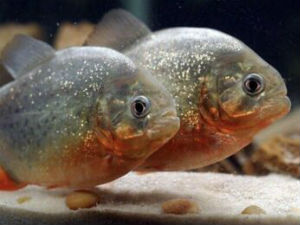
Do Red-bellied Piranhas Migrate?
 The legend of the piranha depicts a ruthless killer relentlessly stalking prey along Amazonian waterways. However, the reality is that most piranha species strategically migrate between various riverine habitats in sync with seasonal flood cycles. Setting aside their sensationalized reputation as sedentary predators, piranhas actually exhibit impressive migratory behaviors. While not embarking on thousand-mile marathons like salmon, localized piranha migrations allow utilization of ephemeral resources across vast floodplains. Whether dispersing to spawn, following prey, or escaping harsh conditions, temporary relocations are key to their success. Let's examine why migration forms an integral part of the piranha's life history strategy and how seasonal movements allow them to flourish in dynamic Amazon environments.
The legend of the piranha depicts a ruthless killer relentlessly stalking prey along Amazonian waterways. However, the reality is that most piranha species strategically migrate between various riverine habitats in sync with seasonal flood cycles. Setting aside their sensationalized reputation as sedentary predators, piranhas actually exhibit impressive migratory behaviors. While not embarking on thousand-mile marathons like salmon, localized piranha migrations allow utilization of ephemeral resources across vast floodplains. Whether dispersing to spawn, following prey, or escaping harsh conditions, temporary relocations are key to their success. Let's examine why migration forms an integral part of the piranha's life history strategy and how seasonal movements allow them to flourish in dynamic Amazon environments. Piranhas are largely river fish, but do they migrate long distances like salmon? While not embarking on epic cross-country journeys, some piranha species do exhibit migratory behaviors between different river habitats.
Red-Bellied Piranhas
The red-bellied piranha (Pygocentrus nattereri) exhibits some distinct migratory behaviors tied to seasonal flood cycles:
- At the start of the rainy season, schools migrate out of main rivers into newly flooded forests to feed and spawn. This allows young access to abundant food.
- As floodwaters recede, red-bellies migrate back into permanent water bodies. Some may travel over a kilometer.
- Localized migrations up and down rivers follow prey fish movements. This maximizes access to food sources.
- Some populations occupy home ranges of just a few kilometers while others migrate longer distances seasonally.
- Schools may temporarily relocate to avoid areas of low dissolved oxygen levels.
So while not embarking on immense migrations, red-bellied piranhas move opportunistically within river basins in sync with seasonal hydrological changes to utilize resources. Their life cycle revolves around migratory behaviors.
Rainy Season Spawning Migrations
Some piranha species migrate from main river channels into flooded forests and tributaries to spawn when water levels rise during the rainy season. These seasonal migrations allow young access to abundant food and shelter.
Dry Season Home Range Shifts
As waters recede in the dry season, piranhas will abandon drying pools and relocate into deeper permanent water bodies. Localized movements between adjacent habitats help ensure year-round access to resources.
Following Food Sources
Piranhas may also migrate in pursuit of seasonal food sources. Migrations up and down rivers follow movements of fish upon which they prey. This maximizes access to vulnerable prey populations on the move.
Exceptions to the Rule
Some piranha species are non-migratory and complete their entire life cycle within a local home range only kilometers wide. But habitat shifts are a key survival strategy for most.
In summary, while not embarking on thousand-mile marches, seasonal migratory movements synchronized with hydrological cycles allow most piranha populations to flourish across Amazon floodplain environments. Their life history strategies have evolved around migrating to utilize ephemeral resources.